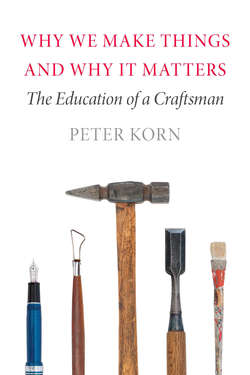Читать книгу Why We Make Things and Why It Matters - Peter Korn - Страница 6
На сайте Литреса книга снята с продажи.
ОглавлениеIntroduction
I BELONG TO a generation of furniture makers to whom woodworking initially presented itself as a lost art from a more authentic time. When I turned my first clear pine board into a cradle, and for many years thereafter, I was beguiled by rediscovering the how of craft. How do you sharpen a chisel? How do you cut a sliding dovetail? How do you make a chair comfortable? Eventually, though, I also began to wonder about the why. What is craft and why does it matter? Why do we make things? Or, more specifically, why do we choose the spiritually, emotionally, and physically demanding work of bringing new objects into the world with creativity and skill?
The answers I have found – through considering the work of my own hands, through the practical education of a life in craft, and through the shared experiences of others – all seem to lead back to one fundamental truth: we practice contemporary craft as a process of self-transformation. Why this should be so and what its ramifications are, not only for craft and other creative fields, but also for understanding our own humanity, is the subject of this book.
More than five years ago I told myself that if I put down at least one word a day about the things that deeply mattered to me, I would be ahead of where I was not writing about them at all. My previous efforts as an author had been in the how-to genre. Books such as The Woodworker’s Guide to Handtools (Taunton Press, 1998) and Woodworking Basics: Mastering the Essentials of Craftsmanship (Taunton Press, 2003) were relatively straightforward to write. I knew in advance the material I had to cover, so all I needed to do was construct a thorough outline and put flesh on the bones as clearly and accurately as possible. Not so this book! The slow, focused work of translating elusive perceptions about the why of craft into language, one tentative word at a time, has taken surprising turns. Every statement has provoked new questions, until finally I have found myself mapping out terrain hitherto invisible to me. I could never have imagined, for example, the extent to which I now see individuality as an illusion, the formation of identity as a full-time project, and thought as a phenomenon independent of language.
In short, writing this book has been a remarkable process of discovery. This is only fitting, since what I have come to see, bottom line, is that creative effort is a process of challenging embedded narratives of belief in order to think the world into being for oneself, and that the work involved in doing so provides a wellspring of spiritual fulfillment.
